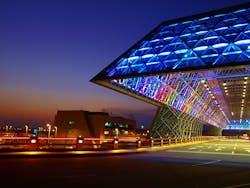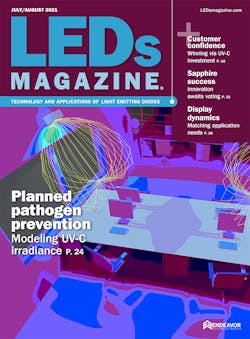“Turn off the lights!” How many times were you told that when growing up? Even as adults, some bad habits are hard to break.
Today, many lighting engineers are focused on LED lighting control in smart buildings. With the advent of LED-based solid-state lighting (SSL) and its ability to be interconnected into electronic systems, we no longer need to be reminded to turn off the lights when we leave the room.
Artificial intelligence (AI) is impacting almost every field and application space in our society. This includes the areas and rooms in which we live and work. Smart cities, where intelligent sensing and processing networks, and AI and machine learning (ML), are endeavoring to transform our surroundings by thinking entirely for themselves.
The arrival of AI promises the commissioning of building lighting control and automation to save money. It will also reduce energy consumption and waste, and improve service quality and customer satisfaction. AI will act as an unseen intelligence that stands in for us, going around and physically turning off the lights. AI will engage its decision-making capabilities to help provision future smart buildings. Let’s examine how AI and LEDs together will enable the next generation of advancement in lighting control.
Smart lighting control
Smart lighting control systems comprise LED lighting systems that have communication and controls integrated into them. This integration permits greater automation and flexibility. Not limited by fixed-wired connections, wireless communication aids in covering vast distances. Control flexibility increases because the overall lighting response can get tuned at three critical levels:
- Overall (macro level)
- Edge (local level)
- Particular (device level)
In such systems, smartphones, computer systems, or wall-fixed devices can function as control and switching stations. The LED lighting systems’ overall color or white levels can receive adjustment by manipulating red, green, blue, and white combinations. Their adjustments will provide the specific wavelengths and correlated color temperature (CCT) desired by the user. Output light levels, measured in lumens, can be adjusted to control the amount of optical power delivered to specific locations. One single system can be coordinated in a way that all lamps, recessed lights, architectural (indoor/outdoor), signage, and landscape lighting function in a unified manner.
AI learns faster than you and I
I attended school for many years to learn all sorts of things. Some things, such as various historical facts, I nailed down quickly. In contrast, other things, such as quantum physics and handling Laplace transforms as easily as basic mathematics, took me many years to achieve some form of mastery (slowly, over time, much of that has started to erode).
AI is a significant technology disruptor. One of the characteristics that AI brings to smart lighting is learning. AI is a faster learner than you and I. AI allows smart lighting systems to improve their performance in a manner analogous to feedback in an electronic circuit. This learning and refinement function is called machine learning.
ML requires the successful handling of large amounts of data by computers. As this vast assemblage of data is analyzed, the computer is allowed to make decisions. These decisions are called inferences, which are conclusions reached based on evidence and logical reasoning. This type of processing is well-suited to a computer. AI is like a version of the fictional private detective Sherlock Holmes on computational deductive steroids.
The computer system learns by one of three methods:
- Supervised learning
- Unsupervised learning
- Reinforcement learning
Supervised learning works by providing and comparing the desired best correct answer response (output). Unsupervised learning is supervised learning’s complement. In contrast to supervised learning, it does not contain any information regarding the desired, best correct answer response (output). Reinforcement learning provides appropriate positive or negative feedback based on the best correct response (output). Because computers have high data processing capabilities, they can make dramatic jumps in their reinforcement learning performance rather quickly. This comparison of quickness is relative to humans, who do so without the aid of computers.
Here, there, everywhere
A plethora of industries are now incorporating AI. Banking, retail, automotive, and medical are all sectors that have taken a significant leap in employing AI. Although AI will be pervasive, it will likely be adopted across various sectors at different paces. Over time, knowledge and lessons learned in these fields will flow over into the industrial and lighting control application space.
The breadth and scope of the industrial control sector, including smart LED lighting, is enormous. Organizations with particular and specific knowledge of their smart lighting control and automation parameters will adapt faster than those who have farmed this duty to outside firms.
AI and ML implementation are easier for organizations that have initial conceptions of how they should address learning algorithms to tackle the specifics of their organizational challenges and goals. Understanding the existing system’s limitations and interrelations will provide specific areas for focusing and applying AI in building lighting control and automation solutions. AI can be tailored to address application-specific areas that the organization desires to control and automate. It is a tool that has many uses. Like a handyperson with a well-equipped tool belt, it has at its disposal a wide variety of contexts and applications.
Because of the diverse activities within the industrial space, standard higher-level functions will yield the primary market entry points with the greatest level of return on investment. Areas where human safety, overall security concerns, and risks represent large financial exposures will likely be the first industrial areas employing large amounts of AI. Also, industrial AI applications such as smart LED lighting, where relatively similar high-level systems can be quickly adapted and modified, represent areas for adoption. Organizations should be looking at and strategizing how AI offers the possibility of increasing efficiency and efficacy.
Reducing human intervention
AI enables systems and devices to operate while requiring little or no direct human supervision or control. Successful building automation leads naturally to better building LED lighting control that can save money by reducing energy consumption and waste. All this provides an improved level of service quality and customer satisfaction.
A fine example of AI in an office setting would be building LED lighting control and automation changes that respond to the sun’s location changes throughout the day. This adjustment is made through proper synchronization with the measured amount of illumination being received from the sun and then adjusting for various locational and output illumination requirements needed by multiple consumers.
Conclusion
AI will enable the commissioning of building lighting control and automation. That’s not to mention how AI will help society move in a positive direction to save money, reduce energy consumption and waste, improve service quality, and increase customer satisfaction because of further advancements in lighting control. Now, if kids would only listen to their parents and remember to turn off the lights when they leave an empty room.
Get to know our expert
PAUL GOLATA joined Mouser Electronics in 2011. As a technology specialist, Golata is accountable for contributing to the success in driving the strategic leadership, tactical execution, and overall product line and marketing direction for solid-state lighting and other advanced technology related products. Prior to Mouser Electronics, he served in various manufacturing, marketing, and sales related roles for Hughes Aircraft Company, Melles Griot, Piper Jaffray, Optics Balzers, JDSU, and Arrow Electronics. Golata holds a BSEET from DeVry Institute of Technology – Chicago, IL; an MBA from Pepperdine University – Malibu, CA; and a MDiv w/BL from Southwestern Baptist Theological Seminary – Fort Worth, TX.
Looking for more in-depth content, events, and research serving the smart buildings market? Visit our sister publication Smart Buildings Technology.
Enjoyed this article? Visit our digital magazine for more like this >>








